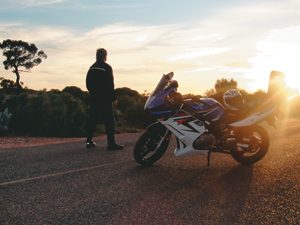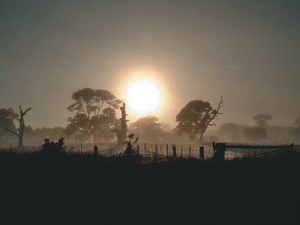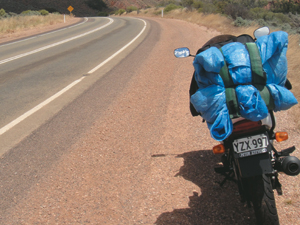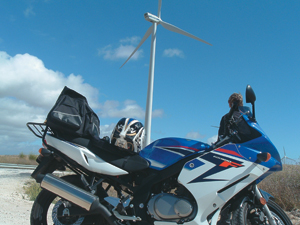Here’s me in Mongolia! 
How to bring your adventures home
Words & photos: John Brown
How many times have you done a great ride and come back to your mates or loved ones and tried to describe what you saw, only to have them smile and say, “That’s nice”? They don’t get it. The scenery was amazing, the food fit for the gods, the ride exhilarating … You and I both know that people who don’t ride are missing out on something that’s almost indescribable. So how do we do convey it to them? Your mission is to tell a story about what you did on your motorcycle ride.
First you must understand that storytelling is an art form. Any good book pulls you in by putting you in the shoes of the main character; standing right next to them as they see the world around them. With the right tools and practice you can do the same with your rides.
Telling stories with photos
This truism is true; a picture is worth a thousand words. Not only will it show everyone what you saw, it will jog your memory and put you back on the bike on that day, giving you the opportunity to remember other things you saw but had nowhere to pull over to get the shot.
Get a good camera…
Good quality cameras are very affordable at the moment so if yours is getting old, consider buying a new one. With riding in mind, I recently bought a small point-and-shoot camera for about $280. It is a 10 megapixel one, takes panoramic shots and is good in low light situations to capture the sunrise and sunset scenes you can never describe. Don’t be confused by all the extra things new cameras offer because you don’t need them. The panoramic feature is a must, though, because it takes one long shot of a landscape that would take three or four shots to cover. There are programs on the computer or Playstation 3 in my case that will zoom in the shot and scroll along so it fills the entire screen and gives a real sense of being there.
…and a tripod 
No matter where you go, you will want to have your motorcycle in a lot of the shots to show you were there. The Bear told me I had to be in the shots for my stories, so I bought a tripod. Once again the prices of some of these are ridiculous but mine is perfect and it only cost about $20. Online shopping is a great way of finding these things and some sellers actually give you a tripod when you buy the camera.
Composing your shots
First, the biggest mistake people make when taking a photo is to not half press the shutter button which allows the camera time to focus properly. Cameras are mini computers these days so take the time to let them do all the work.
Where are you? If you make your bike the star of the photo, it might as well be anywhere because there’s no sense of place.
When taking your shots, try to remember the “rule of thirds” (in other words mentally divide the picture plane into thirds – rather like a tic-tac-toe grid.) That way, be it your bike, a mountain or even cliffs on a beach you won’t be tempted to just plonk your subject right in the centre. Place your point of interest more to the left or the right and include more of the background to give a sense of where the shot is being taken. It may be a great looking native tree or mountain but make the most of the location.
More importantly, something obviously made you pull over in the first place, so play around and try to capture what that was.
If you’re shooting a landscape in low light, try taking it with and without a flash and use your tripod. Although most cameras have an anti-shake feature, every time you use a tripod you eliminate any chance of blurring the shot because your hands are shaking.
Low light photos, if taken right, give a dramatic effect of depth and shadow, so shoot away and experiment with viewpoints.

Buy a large memory card so you can shoot away without worrying about running out of space and you can always delete the bad ones.
Try different formats. If the landscape stretches out into the distance, turn your camera sideways for a vertical shot. This allows you to retain some of the foreground in the shot and give the picture much more depth.
If you’re with a mate and want to take some shots of them riding, focus on one spot and then shoot as they enter your viewfinder.
Always look for something different to shoot instead of the usual postcard shots.
Dear diary…
That’s the photos out of the way, now what about everything in-between. A journal or travel diary is a great way to record all the little things that happen on the road, especially if you go away for extended periods or to new places. You can look back over old rides and see where you would like to go again, identify things you missed that need visiting and remember some of the roads that were an adventure in themselves but that you never want to travel again.
I have a motorcycle planner that allows me to record everything from the date, mileage and fuel price, start and finish points, which roads I took and their quality, the people I met, weather, food expenses, accommodation contact details and price, etc. You could do the same with just a notepad. If you are handy on a computer you could design your own planner. You can create sections for different bikes, states or places you’ve visited. Your imagination is the only thing stopping you.

Showtime
Now you’re set. You can sit around the computer or television and even show the grandkids that you can get out and have adventures that put theirs to shame. But why stop there? The more you do this the better you will become. In the beginning, people may groan remembering the old slide nights that grandpa made them endure, so you need to be sneaky to impress them. There are many sites on the web and local stores that offer photo books for a reasonable price. You have the photos and the information to describe your ride in your travel diary. What’s stopping you? You can involve the family to help you design the layout and make them a part of it. Next thing you know your photobook is on the coffee table so your family can show their friends what they helped to make. Guess who the star of the book is? Well done, you’re famous and may inspire someone else to take up riding or recording their journeys. You may even want to send a ride to this magazine. Just don’t send too many or there will be no room left for mine!
